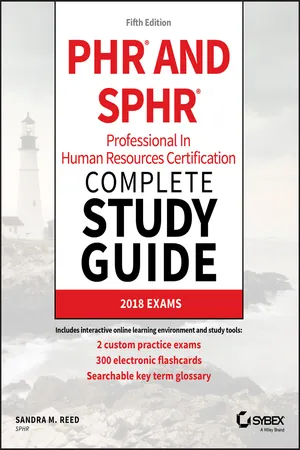Human resources. Ask ten different people what human resources (HR) is or does, and you’ll get at least eight different answers. Business partner, engagement officer, change agents, management adviser, recruiter, talent manager, employee advocate, paper pusher, union negotiator, counselor, policy police, coach, mediator, administrative expert, corporate conscience, and even “chief happiness officers”—these are just a few of the roles that those both inside and outside the profession think we play. Some of these descriptions are based on misperceptions from nonpractitioners, others describe the roles we aspire to attain within our organizations, and some describe what we do each day. The HR Certification Institute (HRCI) provides the
HRBoK™ (A Guide to the Human Resource Body of Knowledge), which is the means by which we define ourselves to the larger business community and that communicates to them what roles are appropriate for the human resource function in an organization. The
HRBoK™ was updated in 2017 to reflect the most current competencies of an HR professional.
The book Victory Through Organization (McGraw-Hill Education), also published in 2017, sheds new light on the correlation of emerging HR competencies to general business principles. Based on the findings of over 30 years of research, author Dave Ulrich succinctly declares that “HR is not about HR. HR begins and ends with the business” (Ulrich, 2017, p. 3). Ulrich and his team identified nine major competencies for a 21st-century HR professional, which include Strategic Positioner, Credible Activist, Paradox Navigator, Culture and Change Champion, Human Capital Curator, Total Rewards Steward, Technology and Media Integrator, Analytics Designer and Interpreter, and Compliance Manager. The identification of these competencies also means that certifying HR professionals will evolve to include the measurement of these nine competencies.
The benefits of professional human resource certification are many. An independent report conducted in 2015 by the Human Resources Research Organization (HumRRO) found that HRCI certification holders report better employment prospects, higher annual salaries, faster income growth, and higher levels of career satisfaction. Additionally, businesses benefit from hiring certification holders, a point made clear by the fact that 98 percent of Fortune 500 companies have HRCI-certified professionals among their leadership ranks (https://www.hrci.org/docs/default-source/web-files/humrroreporthrci-vocwhitepaper.pdf?sfvrsn=2).
This chapter provides you with an overview of HR certification: the growth of human resources as a profession, a little history about the certification process, and a discussion of the types of professional HR certification. (There are seven—PHR, SPHR, GPHR, PHRca, PHRi, SPHRi, and the most recent, aPHR.) This chapter will also review the required eligibility standards for the PHR and SPHR, updated in July 2018 for the first time since 2012. Additionally, you’ll learn about the HR body of knowledge and get a few tips to assist you in preparing for the PHR and SPHR exams.
The Human Resource Profession
By the end of the 19th century, the Industrial Revolution had changed the nature of work—businesses were no longer small organizations that could be managed by a single owner with a few trusted supervisors. As a result, many support functions were delegated to individuals who began to specialize in certain areas. One of these functions became known as industrial relations or personnel and evolved into what we know today as human resources.
As businesses continued to become even larger entities, standards began to develop as practitioners met and shared information about the ways they performed their jobs. The need for more formal training standards in various aspects of this new function became apparent, and colleges began to develop courses of study in the field. By the middle of the 20th century, the personnel function was part of almost every business, and numerous individuals worked in the field. A small group of these individuals got together in 1948 and determined that the personnel function was developing into a profession and was in need of a national organization to define it, represent practitioners, and promote its interests in the larger business community. Thus, the American Society for Personnel Administration (ASPA) was born.
For the first 16 years of its existence, ASPA was strictly a volunteer organization. By 1964, membership had grown from the small group of charter members in 1948 to more than 3,100—enough to support a small staff to serve the members. With membership growing, the discussion quite naturally turned to the topic of defining the practice of personnel as a profession. Although established professions have similar characteristics, such as a code of ethics, a specific and unique body of knowledge, and an education specific to the profession, there are aspects of most professions that set them apart from each other—and personnel was no different. To solicit the contribution of practitioners in this process, ASPA cosponsored a conference with Cornell University’s School of Industrial Relations to determine how best to define the characteristics that made personnel a profession. This conference spawned a year of consideration and debate among ASPA members.
The culmination of this process was an agreement on five characteristics that would set personnel/HR apart as a profession:
- HR would need to require full-time practice.
- The HR profession must be defined by a common body of knowledge that defines a course of study at educational institutions.
- There must be a national professional association that represents the views of practitioners in the larger business community and in the legislative process.
- There must be a certification program for HR professionals.
- There must be a code of ethics for the HR profession.
Once ASPA had a clear definition of what was required for the practice of personnel to be considered a profession, the members knew what needed to be done to make this a reality: Develop a body of knowledge and a certification program to evaluate the competence of practitioners.
Development of the Human Resource Body of Knowledge
With its goal clearly set, ASPA went about the process of developing a body of knowledge for the profession. ASPA created a task force to study and report on the issues involved and recommend a course of action. The ASPA Accreditation Institute (AAI) was formed in 1975 with a mandate to define a national body of knowledge for the profession and develop a program to measure the knowledge of its practitioners.
As a first step in the process, AAI created six functional areas for the Human Resource Body of Knowledge (HRBOK):
- Employment, Placement, and Personnel Planning
- Training and Development
- Compensation and Benefits
- Health, Safety, and Security
- Employee and Labor Relations
- Personnel Research (later replaced by Management Practices)
Over time, as personnel evolved into human resources, ASPA changed its name to the Society for Human Resource Management (SHRM) to reflect changes in the profession. At that point, AAI became...

